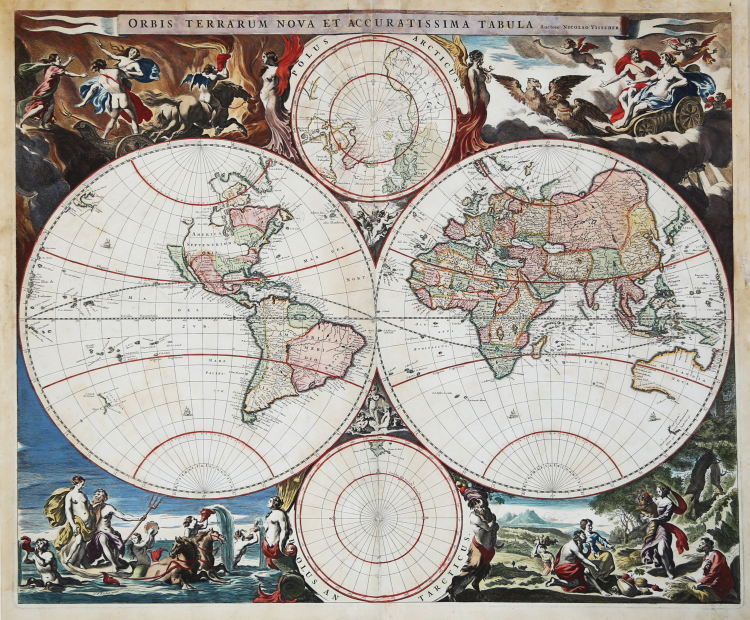



| Reference: | S42723 |
| Author | Nicolas VISSCHER I |
| Year: | 1658 |
| Zone: | The World |
| Printed: | Amsterdam |
| Measures: | 565 x 475 mm |


| Reference: | S42723 |
| Author | Nicolas VISSCHER I |
| Year: | 1658 |
| Zone: | The World |
| Printed: | Amsterdam |
| Measures: | 565 x 475 mm |
Engraved double-hemisphere map of the world, surmounted by north and south polar projections with contemporary fully colored border decoration of mythological scenes, drawn by the Dutch painter Nicolaes Berchem and depicting Zeus and Neptune in chariots, the rape of Persephone and Demeter receiving the fruits of the earth.
Visscher's magnificent Orbis Terrarum Nova et Accuratissima Tabula is one of the most decorative world maps. "It can be regarded as the master forerunner of a number of highly decorative Dutch world maps produced throughout the remainder of the century" (Shirley). Cartographically, the map is largely based on Joan Blaeu's 1648 grand wall map of the world. "For accuracy according to the knowledge of their time, magnificence of presentation and richness of decoration, the Dutch maps of the 17th century have never been surpassed" (Tooley, Maps and Map-Makers p. 29). Shirley 406.
As noted by Rodney Shirley (n. 406): “Visscher's new world map in two hemispheres can be regarded as the master forerunner of a number of highly decorative Dutch world maps produced throughout the remainder of the century. Essentially based upon Blaeu's [wall map of the World] of 1648 . . . the distinct attractiveness of many of the later seventeenth century Dutch world maps can be found in their border decorations . . . [in Visscher's map], artist Nicolaes Berchem has introduced dramatic classical scenes representing the rape of Perephone, Zeus being carried across the heavens in an eagle-drawn chariot, Poseidon commanding his entourage, and Demeter receiving the fruits of the Earth”.
Visscher's world map would become the prototype for not only a generation of large format Dutch World maps, it also inspired a series of reduced sized biblical world maps by Stoopendahl and others.
Etching, impressed on contemporary laid paper and finely hand-colored in period - with recent color retouching - thin margins, traces of glue visible on verso, small restoration in center fold, otherwise in good condition.
Bibliografia
Shirley, The Mapping of the World, n. 406.
Nicolas VISSCHER I (1618 - 1679)
|
For nearly a century the members of the Visscher family were important art dealers and map publishers in Amsterdam. The founder of the business, C. J. Visscher, had premises near to those of Pieter van den Keere and Jodocus Hondius whose pupil he may have been. From about 1620 he designed a number of individual maps, including one of the British Isles, but his first atlas consisted of maps printed from plates bought from van den Keere and issued as they stood with some additions of his own, including historical scenes of battles and sieges for which he had a high reputation. Some maps bear the latinized form of the family name: Piscator. After Visscher's death his son and grandson, both of the same name, issued a considerable number of atlases, constantly revised and brought up to date but most of them lacking an index and with varying contents. The widow of Nicholaes Visscher II carried on the business until it finally passed into the hands of Pieter Schenk.
|
Nicolas VISSCHER I (1618 - 1679)
|
For nearly a century the members of the Visscher family were important art dealers and map publishers in Amsterdam. The founder of the business, C. J. Visscher, had premises near to those of Pieter van den Keere and Jodocus Hondius whose pupil he may have been. From about 1620 he designed a number of individual maps, including one of the British Isles, but his first atlas consisted of maps printed from plates bought from van den Keere and issued as they stood with some additions of his own, including historical scenes of battles and sieges for which he had a high reputation. Some maps bear the latinized form of the family name: Piscator. After Visscher's death his son and grandson, both of the same name, issued a considerable number of atlases, constantly revised and brought up to date but most of them lacking an index and with varying contents. The widow of Nicholaes Visscher II carried on the business until it finally passed into the hands of Pieter Schenk.
|